May 2001 (Part 1)
SELECTION OF QUESTIONS AND ANSWERS
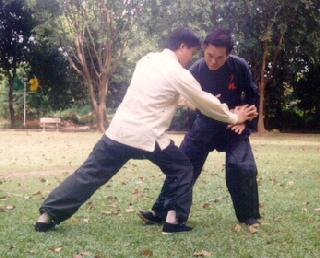
Goh Kok Hin is about to push Sifu Wong away in a Taijiquan Pushing Hands session. Sifu Wong lowers his stance to “swallow” Goh's attack.
Question 1
I have with me a copy of the Shaolin Tiger Boxing of the Beggars' Society of China. The presentation of the kung fu there is for solo demonstration. How will it be applied to real combat?
— Jolex, Philippines
Answer
The term “boxing” is misleading here, because it makes people think of the art with techniques in Western Boxing. It should be replaced by “kungfu” or “martial art”. Hence the art should be called Shaolin Tiger Kungfu, or Shaolin Tiger Martial Art. The techniques in kungfu and in boxing are characteristically different.
Similarly “Shaolin Boxing” and “Tenple Boxing”, which are sometimes used, are misleading. They should be renamed “Shaolin Kungfu” or “Shaolin Martial Art”.
Beggars' Clan was a very large underground organization comprising of beggars. Many of their leaders were kungfu experts.
Shaolin Tiger Kungfu is very effective for combat. But if you only know how to perform a Shaolin Tiger Kungfu set, even beautifully, you would not know how to use it for combat no matter how long you have learnt, and irrespective of whether you learned it on your own from books or from the best teachers.
To be able to use Shaolin Tiger Kungfu for combat you have to fulfill at least the following three tasks.
- You have to learn how to apply Shaolin Tiger Kungfu (not karate, Eagle Claw or any other fighting systems) for combat.
- You have to learn it from a living teacher (not books or videotapes) who himself can apply Shaolin Tiger Kungfu for combat.
- You have to diligently practise what you have learnt.
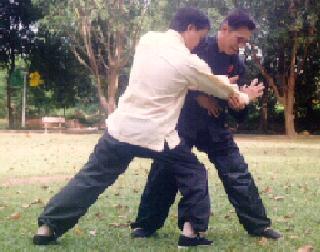
As Goh Kok Hin continues pushing, Sifu.Wong rotates his waist to turn his body to deflect the pushing attack.
Question 2
I also have with me the 18 Arhat methods of Shaolin Kung Fu. It has applied tactics and pre-arrange sparring. I tried comparing both books. It seems that both styles can be combined since Shaolin Tiger Boxing does not have any combat applied tactics.
Answer
The “Eighteen Arahat Methods” of Shaolin Kungfu is what I would call the “Eighteen Lohan Kungfu Set”, or “Eighteen Lohan Fist” as some other masters call it. In Chinese it is “Shi Ba Luo Han Quan” (Mandarin) or “Sap Pat Lor Hon Khuen” (Cantonese). “Fist” here does not refer to a clenched fist; it refers to a kungfu set.
Even if you have learnt the applied tactics well and can perform the pre-arranged sparring correctly, you would be bashed up if you free spar with a karate or taekwondo brown-belt.
Have you seen pre-arranged sparring demonstrations by modern kungfu or wushu students? They are magnificent to watch, and they give the impression to the public that the demonstrators must be formidable fighters. Many people must be very surprised to know that if these demonstrators were to free spar with karate or taekwondo black-belts, the kungfu or wushu demonstrators would receive a bad beating!
Why? Simply because they are magnificent demonstrators, not magnificent fighters. All their training is geared toward making their movements beautiful to watch; they have never spent any time learning how to fight. When they go for competitions, even at international level, judges will award them points for their beautiful movements, and never for their fighting ability.
I wish to clarify that I do not mean to belittle modern kungfu or wushu. Indeed I have much respect for their practitioners, because their training is hard and they are dedicated to their art. But I wish to point out that modern kungfu and wushu are different from traditional kungfu, which is a serious fighting art and not a demonstrative sport.
What you did, although you did not realize it, was insulting a serious martial art, presuming that just because you possess s few kungfu books and had read them, you could be proficient enough to toy with the two styles.
Question 3
I am trying to study kung fu on my own because it is very rare and there is no kung fu school here.
Answer
You can study kungfu on your own, just as you can study medicine or music, and may become quite knowledgeable in it, but you will never become a real kungfu practitioner, the most basic quality of whom is being able to fight — just as you would never become a medical practitioner or a musician, the most basic qualities of whom are treating patients and playing music.
The essential factor in any art, be it kungfu, medicine or music, is practice — not scholarship. Just as you become a good doctor or musician not merely by reading from books but by learning from and practising under a competent professor, you become a good kungfu exponent by learning from and practising under a master.
Real kungfu masters are of course very rare today. If you wish to benefit from them, you have to search for them. But there are many schools which teach external kungfu forms, and these schools are adequate for your present purpose. You will benefit more by learning from them than by attempting to figure out what kungfu application could be.
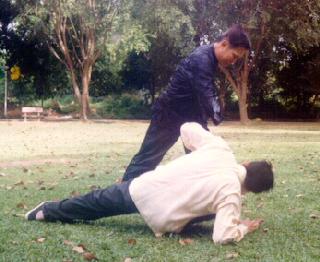
With a twist of his shoulder, Sifu Wong throws.Goh Kok Hin to the ground using the latter's momentum. Notice that the throw is executed not at the shoulder, not with the hands, but from the waist! Such sutble movements cannot be learnt from books or videos, but personally from a master.
Question 4
I also have with me a copy of Taijiquan in 88 forms. The book was edited by China Sports. The book only shows the different forms without showing the combat applications of each form.
Answer
This book presents Taijiquan as a demonstrative sport, and not as a martial art. Hence, there is no mention of combat application nor internal force training, two essential aspects of an internal martial art.
Question 5
I study the different forms to see how they are applied in combat, but it is quite difficult, except for the Iron Palm technique.
Answer
Taijiquan is a very advanced martial art that has evolved over many centuries. In a martial art with only a short history, a punch is a punch and a kick is a kick. That was also what Shaolin Kungfu was, at the beginning of its development. But when Taijiquan evolved from Shaolin Kungfu in the 13th century BCE, Shaolin Kungfu was already very advanced, having developed for more than 700 years. Since then, Taijiquan has developed for another 800 years.
Hence, not only the attack and defence techniques, but all other aspects of combat training, such as tactics, strategies and force training, have become so sophisticated over many centuries that uninitiated persons today would not understand what they mean.
For example, many people wonder why performing Taijiquan slowly and without using strength could ever enable the exponent to fight with speed and force. “Grasping Sparrow's Tail” can be used to counter any attacks, but even teachers who have been teaching external Taiji forms for decades have no idea how this seemingly flowery pattern could be used for combat at all. Therefore, isn't it presumptuous of you to think that merely studying the forms you could understand its profound combat application?
“Iron Palm” is not used in Taijiquan. Attempting to use Iron Palm techniques in Taijiquan indicates your ignorance of Taijiquan philosophy, because Iron Palm training and Taijiquan training are divertingly opposite. In other words, when you progress in your Iron Palm, you diminish your Taijiquan attainment. This, however, does not apply to masters who, having developed the two different arts at different times, can apply them interchangeably or at the same time.
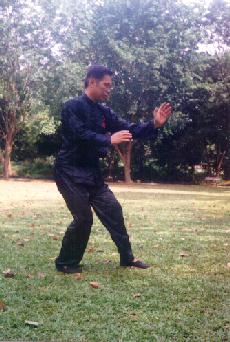
Because Taijiquan has evolved over many centuries, its combat techniques have become so sophisticated that the uninitiated may not realize they can be used for combat. Take for example this pattern called “Playing the Lute”. How can it be used for fighting? Even if they are told that this pattern is an effective method to break an opponent's arm, those who practise only external Taijiquan forms may not know how this can be done.
Question 6
I am acquainted with chi kung also, so the principle of chi circulation is no problem. What I would like to ask is, how does it take for Taijiquan to be a form of martial art? What specific techniques should be used in order not to make the forms just only a dance?
Answer
Although you said you were acquainted with chi kung, your various questions suggest you have no practical chi kung experience. If you had, for example, you would have realized that generating chi flow in Taijiquan and applying an Iron Palm strike are characteristically different.
Asking how it takes Taijiquan to be a martial art, is irrelevant because Taijiquan is basically a martial art. The term “quan” in “Taijiquan” is a shortened form of “quan-fa”, which means “martial art” in Chinese. You are like asking “how does it take English to be a language” or “how does it take a woman to be a female person”. Taijiquan ceases to be a martial art when people abuse it or practise it incorrectly, which actually is the norm today.
All techniques in Taijiquan, including seemingly unrelated ones like merely standing still and crossing the hands in front, are meant for combat purposes. Putting it in another way, not a single technique in Taijiquan is meant for dancing. But today some people have so abused a great, profound martial art, that they even add music so as to dance better.
What you probably wish to ask is how to practise Taijquan as a martial art. The answer is simple, though its implementation may not be easy. Practise it as it was always practised in the past when there was no question of Taijiquan being a martial art. This will include learning personally from a master who teaches it as a martial art, and paying attention to internal force training and combat application.
On the other hand, don't do the following, which you and many other people are doing, but which not a single Taijiquan martial artist normally did.
- Merely study, but seldom practise.
- Compare various techniques from books or videotapes to try to improve them, tacitly thinking you are smarter than the Taijiquan masters themselves who gave you these techniques.
- Incorporate training methods from external arts or sports, like weight-lifting, running and free sparring, into Taijiquan training, thinking the past masters were fools for not knowing these other methods.
Question 7
The book also has Taiji Push Hands. I ask this because I saw your web page which shows some combat applications of Taijiquan. I know very well that it takes more than just practicing the forms to learn how to use them in combat and it is this that I want to know.
Answer
“Pushing Hands”, or Tui Shou, is a very useful link between set practice and sparring, and is excellent for training combat efficiency. It is mainly in Pushing Hands that you develop such essential combat skills like sensing, balance, agility, fluidity of movements and generating internal force.
But if you just practise “Pushing Hands” you cannot fight. You have to progress to the next stage, which is sparring, called Da Shou or “Striking Hands”. On the other hand, if you rush into sparring without going through Pushing Hands, you would not fight well as you would lack the essential combat skills.
You cannot learn Pushing Hands from a book or an e-mail. Most books show only a few pictures, and basically that is what you need for illustration of the basic techniques. In my book, “The Complete Book of Tai Chi Chuan”, I have explained Pushing Hands in great details and have given a lot of illustrations. But even if you can follow my explanation and illustrations correctly, what you get will be very different from training personally with a master.
Many of those who have attended my Intensive Taijiquan Course have verified this statement. When asked, they said there was simply no comparison between learning from my books and learning from me personally. For those who have learnt personally from me, they could carry on practising Pushing Hands; not only they would continue to derive a lot of benefits for both combat and non-combat purposes, they would also enjoy every bit of their training. It would be difficult to understand how this could be so by just reading my book.
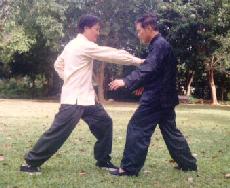
This picture shows what would happen if Sifu Wong failed to counter Goh Kok Hin's thrust punch. How would Sifu Wong respond?
Question 8
It is very hard to find schools of these martial arts here since the more popular ones are those of external martial arts like taekwondo and karate.
Answer
It is not only very hard to find genuine traditional kungfu at your place, but even in China today. In China what is normally taught is modern wushu, which includes modernized Changquan (Long Fist), Nanquan (Southern Fist) and Taijiquan.
The Chinese government has explicitly mentioned that wushu is promoted as a sport, and not as a martial art. The government has done this remarkably well, and has brought a lot of benefits to its people as well as to the world.
But when others stubbornly refuse to accept it as a sport and insist it to be a martial art, that they become disillusioned and frustrated. In the same way, despite being told repeatedly that internal arts need to be learnt from masters, some people insist they can learn from books and videos, and even improve upon the masters by adding outside training methods, that they get no benefits and sometimes injure themselves.
Question 9
It has been a while since I have been in search of a teacher that I feel I would become a great student from. I have visited your website and I am very interested in learning from you. I am so determined that I am willing to travel to Malaysia. Basically I need a fresh start in life and I have come to the revelation that this in the only way I am to find the path of greatness that I have been longing for.
— Konrad, USA
Answer
Many people have written to me with requests similar to yours. Basically they have the following points in common.
- They are sincere in their requests.
- They want to be enlightened.
- They want to save the world, or at least teach others what they set out to learn.
- They think they are the kind of students masters should accept, if not it would be to the masters' great loss.
- They want to be taught according to the ways they like.
The above is the perspective of many young people in the West aspiring to be masters one day. They would benefit much from knowing the typical perspective of Eastern masters whom they wish to learn from. The masters' perspective is as follows.
- Sincerity is a pre-requisite, but there are other required qualities like determination, perseverance, diligence and ready to make sacrifice. Most students say they have these qualities, and honestly think they have, but actually they don't. Masters have many ways to test them.
- Kungfu and chi kung masters do not claim to teach enlightenment. They will ask you to seek enlightenment somewhere else. Almost all these students have no idea of what enlightenment is. Thinking that they can be enlightened in a few months, or even in a few years, is one clear indication of their ignorance.
-
Telling a master that you want to teach others before you even have learnt what you intend to teach, is a clear indication that you are so ignorance about the art and its tradition, as well as so ignorant about the long and difficult task ahead just to become a good student. You also suggest that you are arrogant, for which the masters know you will not make a good student.
But it is different if you mention that you know the way is long and difficult, but you are willing to work hard, and you hope that one day you may prove to be worthy of your master's teaching, and with his blessings you may teach others.
-
It often amazes me why so many people, especially in the West, seem to think that just because they want to learn, a master must teach them. Most masters are not interested to teach. Some of them may not want others to know they are masters.
To many genuine masters, becoming a master is a by-product! They have trained hard for many years, not because they aimed to become a master and then teach the world, but because they wanted to be healthy, full of vitality, live long lives, mentally fresh, and have spiritual joy. They are acknowledged as masters not because they teach others, but because they have mastered the methods leading to these benefits.
-
A master has spent many, many years mastering his art. He knows better than you what, how and when to teach. Therefore, you learn according to his terms, not according to yours.
I have mentioned a few times that those who wish to learn Shaolin Kungfu or Taijiquan from me, the best course of action is, after being familiar with basic Shaolin or Taijiquan forms, to attend my intensive courses.
But some people told me, albeit politely, “No, the best for me is to study with you for a few years, during which time you provide me with food and lodging, and in return I work for you.”
In essence they were suggesting I was not sincere in my statement about the intensive courses, and that they know better than me how to teach them. They should therefore seek another master. Such students also imply, unreasonably and selfishly, that masters have nothing better to do, but to make them masters.
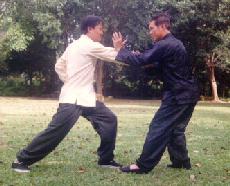
Question 10
I know it seems kind of drastic for an individual to travel from New York to Malaysia just to learn martial arts. However I feel I need to make a move this drastic to actually achieve what I always wanted in my entire life.
Answer
If you wish to attend my Intensive Shaolin Kungfu Course or my Intensive Taijiquan Ciurse, coming to Malaysia is the easiest part. If you think such a trip is drastic and difficult, you should forget about learning kungfu from me.
You should not think that learning kungfu from me would result in you eventually becoming a kungfu master. Although you would have worked very hard and achieved quite a lot in my Intensive Shaolin Kungfu Course and Intensive Taijiquan course, it is only the beginning of a long road to becoming a good Shaolin or Taijiquan practitioner. Only having become a good practitioner, should you start to consider whether you are willing to continue working harder and longer to become a master.
As a genuine Shaolin or Taijiquan practitioner you would have much internal force and be effective in using Shaolin Kungfu or Taijiquan for combat. More importantly, you would be healthy, full of vitality, mentally fresh, and spiritually joyful. But to be a master calls for much more dedicated training. Even if you were to become a Shaolin or Taijiquan master, that may or may not be what you really want in your entire life.
Question 11
I need a new environment that will be conducive in my search for enlightenment. Realistically I have no money but just to take me to Malaysia. If you allow me I will work for my lessons. Will you help me?
Answer
You have no idea what enlightenment is, and how to cultivate towards enlightenment. Very briefly, enlightenment is the practical realization of cosmic reality, called variously by different peoples, such as return to God's Kingdom, attaining the Tao, or Nirvana. The paramount road to enlightenment is meditation, or mind training.
Coming to Malaysia to learn kungfu from me, and cultivating towards enlightenment are different tasks, though Shaolin Kungfu and Taijiquan training can eventually lead you towards enlightenment. The ideal environment is to become a monk and cultivate in a true monastery, which is very difficult to find today. Even if you were a monk, do not expect to be taught enlightenment. You might be asked just to sweep the monastery floor daily.
It is utmost important to realize that becoming a monk is not running away from society nor an excuse to satisfy your fancy, but a very serious responsibility which needs thorough consideration. You are certainly not ready to assume this responsibility.
If you wish to attend my Intensive Shaolin Kungfu Course or Intensive Taijiquan Course, you have to pay the fee. You should also have some prior kungfu or other martial art experience. If you cannot even make an effort to raise the required fee, you are unlikely to have the perseverance to last even the first few days of the course.
Though you may not believe it, the answers to your questions are probably the best help I can give you.
